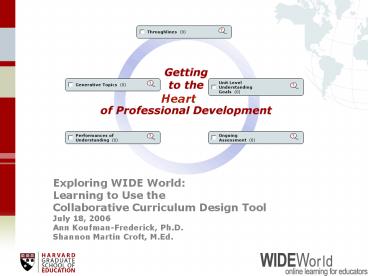Exploring WIDE World: - PowerPoint PPT Presentation
Title:
Exploring WIDE World:
Description:
Goal 3: Explore the structure of WIDE World and the Collaborative Curriculum Design Tool (CCDT) ... Let's Explore 'Understanding' Together... Think of something ... – PowerPoint PPT presentation
Number of Views:72
Avg rating:3.0/5.0
Title: Exploring WIDE World:
1
Heart
Exploring WIDE World Learning to Use the
Collaborative Curriculum Design Tool July 18,
2006 Ann Koufman-Frederick, Ph.D. Shannon Martin
Croft, M.Ed.
2
Inspiring Great Teachingthrough Online
On-site Professional Developmenthttp//wideworl
d.pz.harvard.edu
3
Todays Journey and Goals
- Goal 1 Learn about WIDE Worlds origin and focus
- Goal 2 Unpack the meaning of "Understanding" and
consider how the "Teaching for Understanding"
Framework can be used to clarify and focus
existing practice - Goal 3 Explore the structure of WIDE World and
the Collaborative Curriculum Design Tool (CCDT).
WIDE Widescale Interactive Development for
Educators CCDT Collaborative Curriculum Design
Tool
4
Teaching for Understanding with New Technologies
5
The Challenges in Education
- Take a moment to think about the challenges you
face in your classrooms today. - Now, consider what kind of professional
development could help overcome these challenges.
6
What one teacher shared with us
7
Understanding Exercise
- Lets Explore Understanding Together...
- Think of something that you understand
- How do you know you understand it?
- How did you come to understand it?
8
- Understanding is developed and demonstrated
through performances. - Understanding is a capacity to think and act
flexibly with what you know.
9
The Origins of Teaching for Understanding (TfU)
- 1991-1997 Harvard research project set out to
clarify the nature of understanding, then define
features of educational practices that lead to
deep, flexible understanding - The TFU Framework emerged as researchers and
teachers analyzed effective practice
10
Introducing the TfU Framework
- Essential Educational Questions
- What topics are worth teaching for understanding?
- What exactly do we want students to come to
understand? - How can understanding be developed and
demonstrated? - How can we assess and improve understanding?
11
Introducing the TfU Framework
- Generative Topics What is worth teaching?
- Understanding Goals - What do we want learners to
understand? - Understanding Performances - How can learners
develop and demonstrate understanding? - Ongoing Assessment - How can we assess
understanding?
12
Generative Topics
- What topics are worth teaching?
- Connect required curriculum with students and
teachers interests - Provide multiple entry points
- Are central to one or more disciplines
13
Understanding Goals
- What exactly do we want students to come to
understand? - Connect with standards or required curriculum
- Are made explicit and public
- Align with performances and assessment
- Focus on students understanding of discipline or
topic, rather than recall of facts
14
Understanding Performances
- How can understanding be developed and
demonstrated? - Require active engagement using multiple modes of
learning and forms of expression - Provide opportunities to work with knowledge
- Sequenced to ramp up understanding
- Align with goals and assessments
15
Ongoing Assessment
- How can we assess and improve understanding?
- Makes criteria explicit and public
- Aligns with goals and performances
- Occurs frequently and from multiple sources
- Includes both formal and informal ways to assess
student learning and inform teacher planning
16
Putting TfU to Work
http//wideworld.pz.harvard.edu
17
MyWIDE
18
Collaborative Curriculum Design Tool
- common framework for instructional design
- visual, online workspace
- enables educators to co-create curriclum plans
19
Plan lessons with elements of Teaching for
Understanding
20
Attach files, add links, plan technology,
address standards
21
Collaborate and communicate with colleagues and
coaches
22
Publish Online and Print
23
Take the JOURNEY
http//wideworld.pz.harvard.edu
24
Join the CCDT Community
http//learnweb.harvard.edu/ccdt/join
25
Questions Thanks!
Ann Koufman-Frederick koufman_at_post.harvard.edu Sh
annon Martin Croft croftsh_at_post.harvard.edu ht
tp//wideworld.pz.harvard.edu































